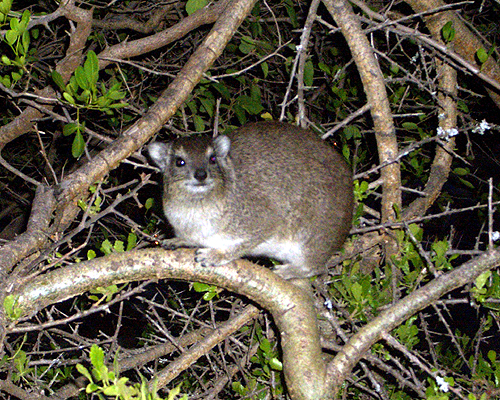 Today, Friday the 13th, I formally apologize to all my readers and past misinformed clients. Turns out that, in fact, elephants are related to hyraxes.
Today, Friday the 13th, I formally apologize to all my readers and past misinformed clients. Turns out that, in fact, elephants are related to hyraxes.
Fifteen hundred rock hyraxes of average weight equals one elephant of average weight but in terms of actual volume, the tree hyraxes’ screeching call approaches the same decibel level of a juvenile elephant trumpeting.
The old safari guide’s myth, sui generis, is reborn! Let it forever prosper. Be damned further negative attempts at phylogenetic propaganda, or put another way remove the whiskey from the camp fire.
I don’t have to tell anyone what an elephant is, (except perhaps a Republican but that’s a different blog). Hyraxes, also known as dassies, are ugly looking little fat African rodents characterized by an ability to freeze in situ with no fear of predation because they smell so bad.
For years and years and years, for longer than old men prefer to recount, we safari guides delighted customers when we discovered one of these smelly unmoving puffballs on a rock.
“So what do you think that is?” we’d ask with delight.
A rat? A giant guinea pig?
“No!” we exclaimed. “The relative of the elephant!”
No!!!!!! they countered, how magical is Africa anyway!
Very magical. We can say anything we like and it’s true! Anyway, that’s the way this story seemed to end about a decade ago when genetic analysis began to clarify the real world.
But the problem is that we safari guides prefer stories to studies, and we don’t read past a scientific title: Discordant Results.
“These discordant results suggest that the species diversification event that defined the three orders of Paenungulata occurred over a relatively short evolutionary time period,” remarked the study that made us all retreat quietly back to the camp fire.
“Discordant” is a big word, but we guides understood that one. We thought, incorrectly, that it was contradicting one of the first DNA studies which did, in fact, link hyraxes and elephant.
But … it really wasn’t.
Thanks to a loyal client and friend, who also fortunately happens to be a scientist, Stephen Farrand recently sent me a phylogenetic tree reinstating the great Safari Myth. It took only a few more exchanges of emails for me to realize how stupid I had been.
Now that I’ve returned to the scientific studies that originally turned all us guides away from story-telling, armed with a real scientist’s perspective, I can affirm that science is right.
About 99-96 million years ago in the late Cretaceous period (when dinosaurs were becoming supreme) there were three animals very closely related: an aquatic thing not similar to a dugong or manatee, the precursor to the mastodon, and an ox-size hyrax.
Those three animals certainly had to have had a common ancestor. Their snouts, trunks, toes and digestive track were all similar. They were and remain in the collective grouping or clade of taxonomic categories known as Paenungulata, or “almost ungulate.”
Then there were at least two radical evolutionary “pulses.” This means there was rapid evolutionary divergence, and believe me, Donald Trump can change his position six times in a minute, so you’ve got to believe that in the ensuing 90 million years they started not to look alike.
But the vestiges of shared holidays remain: that little smelly puffball with a ridiculously screeching voice has a 6-month gestation period. It still has the same number of toes as an elephant. Its extended snout is almost a trunk.
And it is, and forever will be, one of the best stories we old guides have!